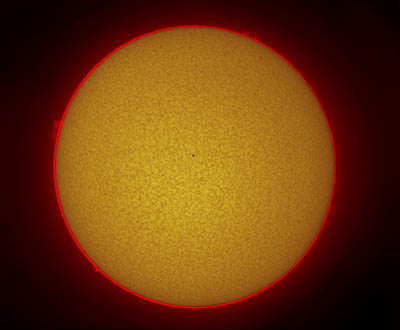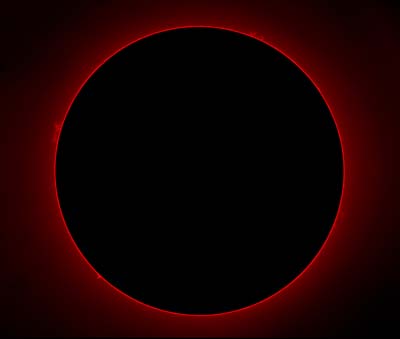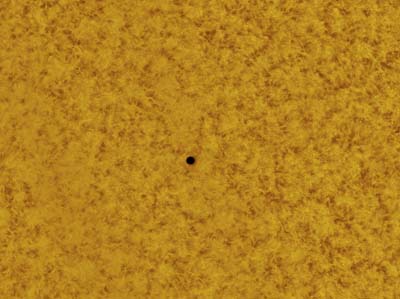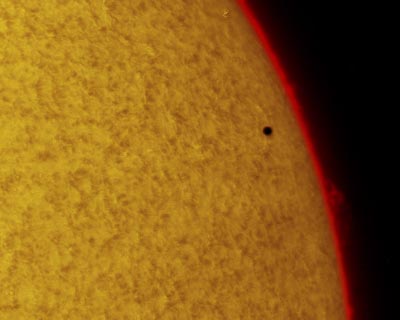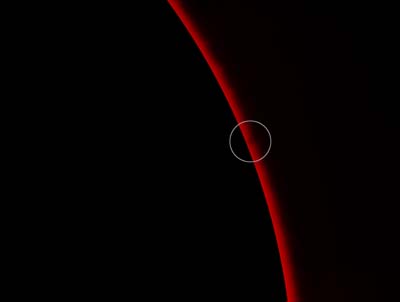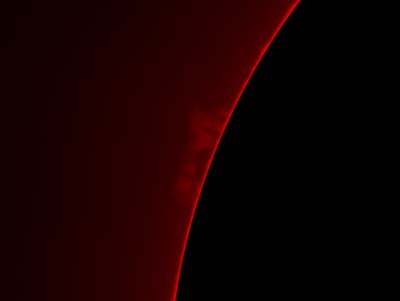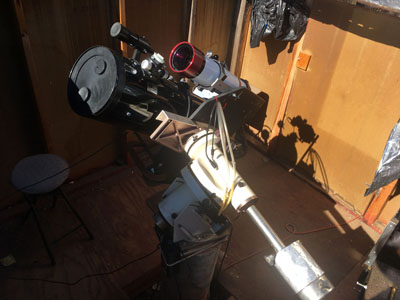Sun in HAlpha With Lunt LS100THa Uploaded 11/16/19 The Mercury Transit Monday, November 11, 2019
Click on thumbnails below for the larger view
Only or twice each decade does the tiny planet move across the solar disk. This year, we have the second transit in a single decade, the last one being in 2016. For this event, the sky was clear, seeing was average and we obtained dozens of fine shots in the light of Hydrogen Alpha with our solar scope.
Halpha:
Below - Full disk shot including the red hydrogen prominences on the limb
Mercury is the small black dot in the center of the disk. It is very tiny indeed, only 11 arc seconds across!
Below - A longer exposure of the Chromosphere that surrounds the Sun
With the overexposed disk of the Sun blacked out similar to a total eclipse, we can easily see a ring of spicules as a furry edge on the sun, and the prominences as firey looking clouds hovering over the limb suspended by magnetic fields.
Below - 3X close up of Mercury in the center of the suns disk
Fine mottling on the sun at this wavelength is due to short filaments of plasma forming rings and connected chains of darker material.
Below - Mercury heading off the Sun, heading for the limb
One very nice prominence is seen on the lower right corner on the limb of the sun. The "furry" edge is countless thousands of Spicules, which are small flare like rays that shoot out of the sun constantly and last perhaps 15 minutes each before fading out.
Below - Mercury is now moved off the disk of the Sun but can still be seen as a dark disk (circled)
Another edge chromosphere shot with the over exposed disk of the sun blocked out. Look inside the circle and you can see most of Mercurys round shape superimposed.
Below - A larger Prominence hovering over the limb on the other side of the Sun
Would have been nice to have Mercury pass over this one, you would be able to follow its shadow much further out past the edge of the Sun!
Below - Our solar telescope used to image the event, mounted piggyback on the 10 inch Astrograph.
The four inch Lunt solar scope seen with the red objective housing is a narrow band, pressure tuned high resolution instrument, and has served us well in our solar research endeavors. The camera used is a Imaging Source DMK51 which was developed primarily for robotic vision and scientific imaging with high detail.
Instruments: Lunt LS100THa Halpha Platform: Astrophysics 1200 Camera: DMK 51 Location: Payson, Arizona Elevation: 5150 ft. Sky: Seeing 7/10, Transparency 9/10 Outside Temperature: 45F Processing: Registax 6, Photoshop CS2 Solar Home Page HOME SCHMIDT GALAXIES EMISSION NEBS REFLECTION NEBS COMETS GLOBULARS OPEN CLUST PLANETARIES LINKS
